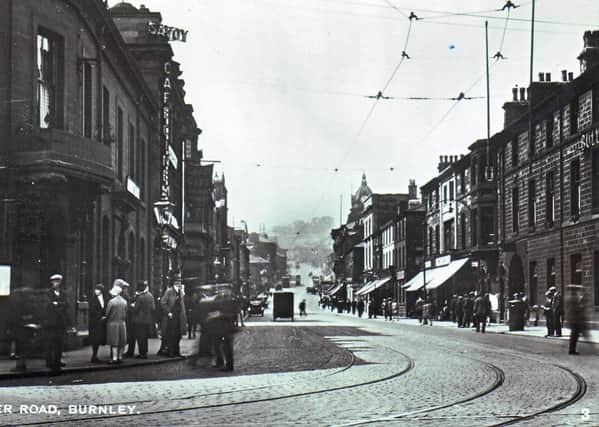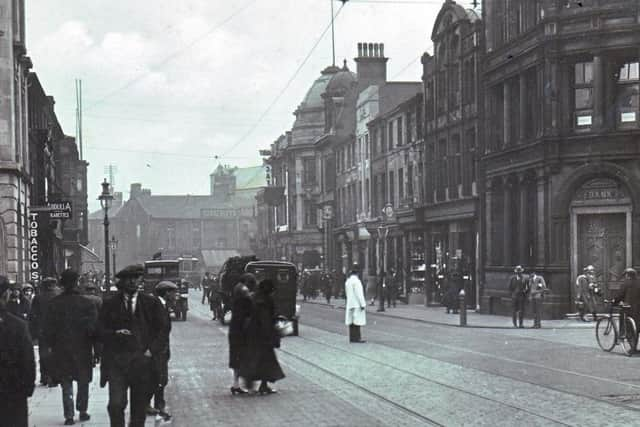The missing domes on Burnley Town Hall


Last week I published an article on the Top o’ th’ Town area (the old centre of Burnley around St Peter’s) in which I included two old images taken from different positions. I am pleased to say a number of you have contacted me and said they enjoyed the article.
I have decided, therefore, to repeat the exercise with Manchester Road. This article is illustrated with two old postcard views of Manchester Road, one taken from its junction with St James’s Street and the other (taken in the opposite direction) from just above Hargreaves Street. Of course, this is the area to which the town centre moved in the latter part of the 18th Century.
Advertisement
Hide AdAdvertisement
Hide AdI do not think there are many years between these cards. In fact, I think that, though not named on either card, it is likely they were made by the same firm which may have been Lupton’s, the Burnley booksellers, which once had premises in Manchester Road.


The first postcard dates from before 1933 as the Bull Hotel is still standing in this picture. The Bull was Burnley’s premier hotel when it was built about 1819 by the colliery-owning family of Hargreaves, after whom the nearby street is named.
One of their early mines was situated near Hargreaves Street. It was a very primitive affair and it is known that the power for the operation was provided, not by water, or a steam engine, but by a horse gin! The family owned quite a lot of property hereabouts, accounting for other street names – Ormerod Street, named after the house where the family lived, and Yorke Street, named after General the Hon. Sir James Yorke Scarlett, who married Charlotte Hargreaves, one of the co-heiresses of the Hargreaves collieries.
I have long since been amused by the fact Charlotte’s married name became Charlotte Scarlett. It might not seem all that amusing to you but when my parents saddled me with my full name – Roger Barstow Frost – I think I can be forgiven for finding something funny in the names of others!
Advertisement
Hide AdAdvertisement
Hide AdThe Bull, in the first picture, can be seen on the right. The name is just visible above the fifth first floor window on the extreme right. Originally, the Bull had been a small farm – it is called a croft in some sources – with lands stretching up to the banks of the River Calder, where Burnley Town Hall now stands. You can see the Town Hall in this picture. It is partly obscured but its famous dome can easily be made out. In fact, the subject of domes in this part of town is something to which I will return.
On the left of this image, the large dark building is the Old Red Lion which has a connection with the Town Hall in that, in the 1860s, Burnley, not then having its own Town Hall, a famous Lancashire brewer and Burnley Corporation competed for the site. One wanted to build a significant pub, the other saw the site, which then was larger than you might have thought, as the ideal place for a Town Hall. Needless to say the brewer won, something which does not worry me all that much as I prefer the site of the present Town Hall to that of the Old Red Lion.
The Old Red Lion and the Bull have something in common. Both had crofts – plots of land - behind them, and these are remembered in Red Lion Street and Bull Street. The latter has long since been the home of the Burnley Express.
If you look carefully at the first postcard images, you will notice the Savoy is just above the Old Red Lion on Manchester Road. A sign for the Savoy can be seen high up on the building and below that sign there are others which inform us that the building was a café and a cinema. The Savoy was a purpose-built cinema which opened in 1922, at the end of the silent film era but, in its day, was very well known for the silver service café which operated from the floor above the entrance to the “pictures”, as we called the cinema.
Advertisement
Hide AdAdvertisement
Hide AdI only went into the café once, and I can recall being mightily impressed with the whole set-up, the quality of service and, in my case, a splendid chocolate cream cake! Somehow, the cup of tea I was served (from a silver teapot) does not seem to resonate quite so much in my memory, but I can still taste that cream cake!
You might be able to make out – top, left of centre – one of the domes already mentioned. If you look really carefully, you will be able to see the dark outline of another, this latter part of the old Midland Bank, now the disgraced HSBC. In fact HSBC are thinking of re-inventing themselves by returning to Hong Kong, from where they came, and reviving the old Midland name. Just a thought – that name is not all that much to be proud of. Once the largest deposit bank in the world, the Midland found itself in difficulties, through the incompetence of its directors and, in 1992, was taken over by the HSBC. Incidentally, the Burnley branch of the Midland was built in 1910.
I could say more about this photo but we need to consider the second image. Of the two, I think this is the better composition. The figures are much clearer and the card is not as dark as the first we looked at. I also like the image of the policeman on traffic duty.
It is on this card you can see, most clearly, the two domes I have mentioned. I like to think of Manchester Road as “Dome Street” because of the three architectural features which adorn the street scene. On this card the dome on the Midland is first. Smaller than the dome on the Savoy, the one on the Midland is seen shown against the one on the Savoy.
Advertisement
Hide AdAdvertisement
Hide AdManchester Road might be distinctive because of its three domes but there should have been five! On the original plans there were to have been three domes on the Town Hall. Only the central dome was built and this not to the original specification. Neither of the two flanking domes were constructed because the three-year project to build the Town Hall was running out of funds by 1887 and it was decided to make last-minute alterations to the plans.
On the left of the second image, the first building of which we can see very much is the Yorkshire Bank of 1924 which is one of the very few buildings in Burnley to be built out of Portland stone. You might be able to see a name in one of the upper windows of this building. This refers to Jobling and Jobling, one of Burnley’s better known firms of solicitors. The adverts - “Tobacco” and “Abdulla Cigarette’s” - were on the premises of J. Bowker and Co Ltd, tobacco factors, as they are described in the 1927 Commercial Directory.
On this row of property there were once a number of very well-known Burnley firms, not now remembered by many locals. One was Bulcock’s, the ironmonger’s. I think this is the shop with the large projecting windows to the left of the street lamp. When I was a boy, I recall the shop having a big upper window and asking myself why the shop should have such a large window at first floor level? Another of the shops was the costumiers, Nicoll’s. The Big Window, originally the New Red Lion, was just below Nicoll’s.
On the other side of Manchester Road, the large building with the huge front door is the former Burnley branch of the Union Bank of Manchester. It was designed by the Burnley architect, William Waddington, and it was opened in 1894.
Advertisement
Hide AdAdvertisement
Hide AdAgain, the row of shops, between the Midland and the Union banks, was home to some of Burnley’s best known firms. Perhaps the most famous, in its day, and at number 18 Manchester Road, was Shee and Kennedy Ltd, the men’s tailors and outfitters. The row also contained the Café Royal, another silver service restaurant; the Burnley offices of the Northern Daily Telegraph (now the Lancashire Telegraph - this is the lighter coloured building recently rebuilt when this picture was taken) and the watchmakers, formerly run by one of Burnley’s mayors Alderman Scott, of Scott Park fame.
I hope you have enjoyed this look back at Manchester Road in Burnley as it was c1929.